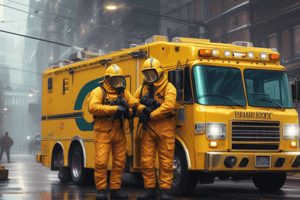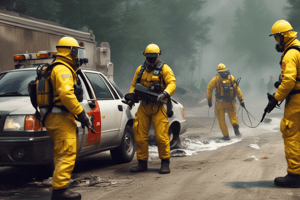Podcast
Questions and Answers
What should law enforcement units assist citizens with during a HAZMAT incident involving toxic or irritant vapors?
What should law enforcement units assist citizens with during a HAZMAT incident involving toxic or irritant vapors?
- Shutting down ventilation systems (correct)
- Shutting down electrical systems
- Providing medical assistance
- Evacuating by boat
Which zones are established by Hazmat personnel during a hazardous materials incident?
Which zones are established by Hazmat personnel during a hazardous materials incident?
- Danger, Risk, Safe Zone
- Critical, Non-Critical, Periphery Zone
- Immediate, Secondary, Remote Zone
- Hot, Warm, Cold Zone (correct)
What is the primary method of action for Operations Level personnel when dealing with HAZMAT incidents?
What is the primary method of action for Operations Level personnel when dealing with HAZMAT incidents?
- Ignoring established safety protocols
- Engaging in offensive tactics
- Using Level A PPE to enter Hot Zones
- Performing actions in a defensive manner (correct)
Why should Operations Level workers avoid entering the Warm zone without direct supervision?
Why should Operations Level workers avoid entering the Warm zone without direct supervision?
What is one of the containment options available to Operations Level personnel at HAZMAT incidents?
What is one of the containment options available to Operations Level personnel at HAZMAT incidents?
When should face-to-face communications be preferred during a HAZMAT incident?
When should face-to-face communications be preferred during a HAZMAT incident?
What communication standard is used during HAZMAT incidents?
What communication standard is used during HAZMAT incidents?
What is the role of Command in relation to civilian safety during an incident?
What is the role of Command in relation to civilian safety during an incident?
What is the primary purpose of the action plan in a hazardous materials incident?
What is the primary purpose of the action plan in a hazardous materials incident?
Which zone is established around the immediate danger from hazardous conditions?
Which zone is established around the immediate danger from hazardous conditions?
What should be done if a particular resource needed for control is unavailable?
What should be done if a particular resource needed for control is unavailable?
What is the role of the perimeter established around a hazardous area?
What is the role of the perimeter established around a hazardous area?
What should be done regarding personnel movement in the Limited Access Zone?
What should be done regarding personnel movement in the Limited Access Zone?
What is the Evacuation Zone associated with in a hazardous material incident?
What is the Evacuation Zone associated with in a hazardous material incident?
Why is establishing a Limited Access Zone critical during an incident?
Why is establishing a Limited Access Zone critical during an incident?
How should accountability of personnel entering and leaving the Limited Access Zone be managed?
How should accountability of personnel entering and leaving the Limited Access Zone be managed?
What is the purpose of the Standard Operating Guidelines for Hazardous Materials situations?
What is the purpose of the Standard Operating Guidelines for Hazardous Materials situations?
What type of incidents are included in the scope of Hazardous Materials incidents?
What type of incidents are included in the scope of Hazardous Materials incidents?
What foundational requirement is emphasized for dealing with hazardous materials incidents?
What foundational requirement is emphasized for dealing with hazardous materials incidents?
What is the primary role of the first arriving unit at a hazardous materials incident?
What is the primary role of the first arriving unit at a hazardous materials incident?
What does the Blue Card command system ensure during a HAZMAT incident?
What does the Blue Card command system ensure during a HAZMAT incident?
Why are safety precautions necessary at every event involving hazardous materials?
Why are safety precautions necessary at every event involving hazardous materials?
Which of the following describes the way incidents should be approached according to the guidelines?
Which of the following describes the way incidents should be approached according to the guidelines?
How does the command system for a NIMS Type 4 and 5 HAZMAT incident differ from standard structure fire commands?
How does the command system for a NIMS Type 4 and 5 HAZMAT incident differ from standard structure fire commands?
What is the primary objective when evaluating a hazardous materials incident?
What is the primary objective when evaluating a hazardous materials incident?
Which of the following is NOT a factor to consider in assessing a hazardous area?
Which of the following is NOT a factor to consider in assessing a hazardous area?
What should be included in the Initial Radio Report (IRR) for a HAZMAT incident?
What should be included in the Initial Radio Report (IRR) for a HAZMAT incident?
Who should be consulted for additional information at a hazardous materials incident?
Who should be consulted for additional information at a hazardous materials incident?
What is a key difference between a structural fire and a HAZMAT Initial Radio Report (IRR)?
What is a key difference between a structural fire and a HAZMAT Initial Radio Report (IRR)?
After the initial size-up, what does Command primarily focus on?
After the initial size-up, what does Command primarily focus on?
What is the importance of looking for labels and markers during a hazardous materials evaluation?
What is the importance of looking for labels and markers during a hazardous materials evaluation?
Which report provides more accurate and detailed information following a HAZMAT incident?
Which report provides more accurate and detailed information following a HAZMAT incident?
What is the primary concern during emergency decontamination procedures?
What is the primary concern during emergency decontamination procedures?
What should be done before treating victims in an emergency decontamination situation?
What should be done before treating victims in an emergency decontamination situation?
What is a recommended action for people undergoing emergency decontamination?
What is a recommended action for people undergoing emergency decontamination?
In the case of a heat-related illness developing during a hot zone entry, what should a member do?
In the case of a heat-related illness developing during a hot zone entry, what should a member do?
Who should determine if a hazardous product release requires notification of the State Police?
Who should determine if a hazardous product release requires notification of the State Police?
What must the first arriving officer include in their command page notification?
What must the first arriving officer include in their command page notification?
What should operations level teams focus on during a hazardous materials incident?
What should operations level teams focus on during a hazardous materials incident?
Why is it important to refer to the ERG, Chemtrec, or technical response teams during an incident?
Why is it important to refer to the ERG, Chemtrec, or technical response teams during an incident?
Study Notes
Bernalillo County Fire & Rescue Standard Operating Guidelines
- Purpose: To outline a basic philosophy and strategic plan for Hazardous Materials (HAZMAT) incidents
- Scope: Covers a wide range of situations involving hazardous materials, including fires, spills, transportation accidents, chemical reactions, meth labs, and explosions
- General Guidelines:
- All incidents potentially involve exposure to hazardous materials, even ordinary fire situations, requiring appropriate precautions
- Full protective clothing (including SCBA) and special protective clothing are crucial for every HAZMAT incident
- The use of Standard Operating Procedures (SOPs) is essential
HAZMAT Incident Command System
- Command System:
- NIMS Type 4 and 5 HAZMAT incidents use the same Blue Card command system as other incidents.
- The Incident Commander (IC) must have HAZMAT Operations level training for OSHA 1910.120 compliance
- The 8 Functions of Command are applied differently for HAZMAT compared to structural fires, with a focus on managing HAZMAT entry.
HAZMAT First Response
- First Arriving Unit:
- The first arriving company and Battalion Commander respond to the scene upwind and defensively (Cold zone).
- All other companies stage at Level 2 staging location designated by the first arriving unit or dispatch.
- Prior to entering the scene, evaluation by a Hazardous Materials Technician Team member is recommended for safety.
- Incident Assessment:
- Immediately identify a hazardous area based on potential danger, considering factors such as materials involved, time of day, wind and weather, location, and risk to unprotected personnel.
- Evacuate or rescue people in critical danger, prioritizing rescuer safety.
- Determine the type of materials involved and the hazards presented as the primary objective.
- Identify labels, markers, DOT numbers, NFPA placards, shipping papers, and any other available information.
- Refer to pre-fire plans and solicit information from on-site personnel, plant management, and responsible parties.
- Utilize reference materials carried on equipment, and contact Fire Control for additional resources, such as state agencies, fire department specialists, manufacturers, etc.
HAZMAT Initial Radio Report
- Important Note: The Initial Radio Report (IRR) is not considered an affidavit of absolute accuracy, merely a quick snapshot of the incident's hazards.
- Focus: The IRR must provide a "word picture" of the incident's hazards that the IC can see from their command position upon arrival.
- Content for Follow-Up Report:
- Results of a 360-degree assessment (if performed)
- Information on the size, location, and identity of the material(s) involved
- Accountability location
- Any immediate safety concerns
HAZMAT Action Plan
- Key Elements:
- Must ensure safety of all fire department personnel.
- Must include evacuation of the endangered area if necessary.
- Must address control of the situation.
- Must identify the hazardous material (if possible).
- Must include contacting additional resources to mitigate the incident.
- Containment and Control:
- Most hazardous materials are intended to be safely contained for handling and use.
- The emergency situation typically arises when the material escapes its container or protective system, creating an external hazard.
- Identify the hazard control method in the action plan.
- Identify the resources needed to execute hazard control.
- Select a method based on available resources or adopt a "holding action" until necessary equipment or supplies are available.
- Avoid premature deployment of personnel and equipment or experimenting with techniques.
Control of Hazardous Area
- Initial Zones:
- Limited Access Zone:
- This zone encompasses the area where personnel are potentially in immediate danger from the hazardous condition.
- It is the area where the Hot/Warm/Cold zones are established by Command and controlled by the Fire Department.
- Access to this zone is strictly controlled, allowing only personnel with proper protective equipment and an assigned activity to enter.
- Companies remain intact in designated staging areas until assigned.
- Personnel monitor entry and exit points within this zone.
- Limited Access Zones should be geographically described to all units and identified by yellow fire line tape.
- Evacuation Zone:
- This zone is the larger area surrounding the Limited Access Zone, where the degree of risk to personnel is lower.
- All civilians are evacuated from this zone.
- Law enforcement enforces zone limits based on distances and directions established by Command.
- In cases involving toxic or irritant vapors carried downwind, a shelter-in-place strategy may be more effective, with windows and doors closed to prevent contact with the material.
- Limited Access Zone:
Control of Hazardous Area Continued
- Hot/Warm/Cold Zones:
- Once the Hazardous Materials Sector is established, Hazmat personnel define and establish the Hot/Warm/Cold Zones which remain in effect for the duration of the incident.
HAZMAT Operations Level
- Defensive Actions:
- All Operations Level activities are performed defensively.
- Operations Level personnel never enter a HAZMAT IDLH hazard zone (Hot Zone) requiring Level A or B PPE.
- Offensive Actions (Limited Circumstances):
- In cases where all known hazards are identified, Operations Level personnel may take offensive actions to contain/control the release, such as those involving CO, CO2, or fuel spills.
- Warm Zone Access:
- Operations Level workers must be under the direct supervision of a Technician Level operator when entering the Warm Zone.
- Limited Capabilities:
- Operations Level response is limited due to the smaller amounts of HAZMAT PPE, equipment, and resources on their apparatus.
- Control/containment options are limited to defensive actions, such as:
- Applying Class B Foams
- Damming
- Diking
- Plugging (depending on the product)
- Limited ability to shut off control/supply valves (as recommended by the ERG)
HAZMAT Communications
- Face-to-Face Preferred:
- Face-to-face communication is preferred in some HAZMAT incident situations.
- Radio Communication:
- Use separate radio channels for subsequent HAZMAT teams/Branches.
- Mirroring the Blue Card System:
- All HAZMAT incident communications mirror the standard Blue Card hazard zone methods.
- Adapt the system using plain English and HAZMAT-specific terminology.
- The order model is used for all communications.
HAZMAT Emergency Decontamination
- Purpose:
- Establish emergency decontamination procedures in addition to routine ones.
- Prioritize the prevention of loss of life or severe injury to site personnel.
- Immediate Action:
- Decontaminate individuals exposed to extremely toxic or corrosive materials immediately to prevent severe injury or loss of life.
HAZMAT Emergency Decontamination Guidelines
- Prioritize Decontamination:
- Decontamination should be performed before treatment of victims to prevent cross-contamination of EMS workers.
- Protection of Personnel:
- Adequately protect medical personnel and ensure the proper disposal of contaminated clothing and equipment.
- Emergency Decontamination Technique:
- Typically involves using a fire stream to rinse contaminants off.
- Clothing Removal:
- Individuals undergoing emergency decontamination should remove all clothing prior to treatment.
- Privacy Considerations:
- Attempt to protect the privacy of victims by hanging tarps in the decontamination corridor.
- Heat-Related Illness:
- In case of heat-related illness, remove protective clothing promptly to reduce heat stress.
HAZMAT Notifications
- State Police and AFD:
- The first arriving IC-1 officer must determine if a product release or spill (50 gallons or more) requires notification of the State Police for an ERO.
- The first arriving officer should also determine if the spill or release cannot be mitigated at the Operations level and notify AFD to request the Hazmat team.
- Both notifications are requested through Dispatch.
- Battalion Commander Communication:
- Battalion Commanders must send a command page through IAmResponding® App stating:
- Location
- Product (if known)
- Size
- Incident Commander
- Who has been notified and requested
- Evacuations or shelter-in-place status
- Needs
- Battalion Commanders must send a command page through IAmResponding® App stating:
HAZMAT Specific Procedures
- Infinite Combinations
- Due to the infinite combinations of hazardous materials and environmental factors, always refer to the ERG, Chemtrec, subject matter experts, or a technical level response team for the best course of action.
- Defensive Operations:
- Operations-level teams always remain defensive.
Studying That Suits You
Use AI to generate personalized quizzes and flashcards to suit your learning preferences.
Related Documents
Description
Explore the essential guidelines for managing HAZMAT incidents outlined by Bernalillo County Fire & Rescue. This quiz covers the strategic approach, command systems, and necessary protective measures required during hazardous materials situations. Test your knowledge on the protocols and considerations crucial for effective incident management.




